The multi-layered ‘Small Boat, Vast Ocean’:
My Years in Solitary Buddhist Retreat
Written by: Diane Berger
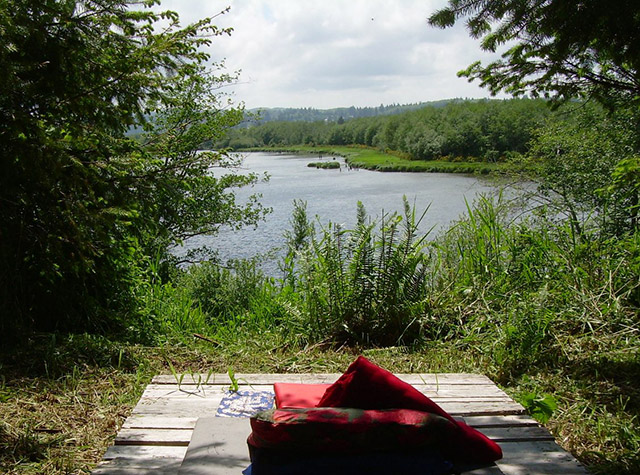
A favorite meditation spot near Raymond, Washington, overlooking the Willapa River.
Photos by: Diane Berger, Kari Holman, Hideaki Inomoto
Diane Berger has published a book – “Small Boat, Vast Ocean” – about her three-year retreat in the Tibetan Buddhist tradition, which took place from 2011 to 2015. This article focuses on the quality and purpose, of the stages of those three years.
Three years, three months, three days. A long time to go away from friends and family, away from society altogether, to dive into the realm of deep psyche, and further, into soul and spirit.
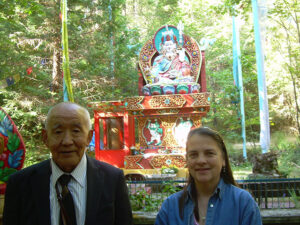
Tibetan lama and Longchen Nyingtik scholar, Nyichang Rinpoche, with Diane in front of Guru Rinpoche statue and koi pond at Williams, Oregon.
It turns out that an initiation of time and solitude is required for such a journey—to enter the nether regions, and to come out the other side, intact. Then the way is cleared for deeper spiritual development. To illustrate, here is a short excerpt from my book, early spring, 2013, in the Siskiyou Mountains of Oregon, during a difficult spot:
Sometimes it seems that the anxiety from being remote and on my own, in solitude, doesn’t come from the present circumstance. Everything is fine. The cabin is lovely; there’s enough to eat; there are people I can call. Instead, it seems to be the feeling that I’m in so far, into the middle of this ocean. I look back in time and it’s been a year and a half since I began retreat. It sounds like a short time, but it feels like several years have passed—in slow, painstaking periods. There’s no way I can return to that shore from which I embarked, nor would I want to. In any case it’s not an option.
Then I look ahead. Only ocean, unfathomably vast in every direction. I seem to know “the” direction, the same course that I set out on. I know there’s a shore there, somewhere. And now I know how it feels to be on my way. Long, slow, ups and downs, changing weather, with little changes of scenery. At this point I’m in the middle section. The prospect of solitude for such a stretch, or sometimes even for another day, sets off anxiety. And yet, when the present moment is revealed to my mind-heart, then there is no problem.
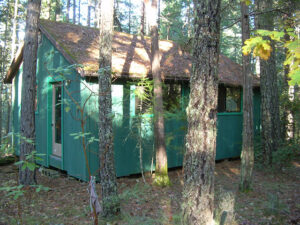
The retreat cabin for Diane’s second stint in Williams, Oregon.
What is it about the three years of retreat that gives it veracity for so many practitioners, a tried and tested form of this ancient tradition? I’ve never asked a Tibetan lama this question before, nor read an official explanation. But I have some inklings from my own experience, and then, from hearing about the experiences of others. In short, there does seem to be an amount of time needed to percolate the essence of the path.
There are typical stages that one goes through over this period of time, and my experience seemed to follow along. The first year is tough, emotionally and psychologically. People are social animals who don’t normally enjoy leaving their society. For some, that aspect makes for an insurmountable hurdle—long retreat definitely should not be undertaken by anyone with psychological imbalances. So there is a clear initiation here, a qualified retreat “master” being vital throughout a long retreat—in the form of the lama checking in on a regular basis. Even in Tibet, long, solitary retreat was considered a risk for mental breakdown, so that’s not a special feature or weakness of Western or modern cultures.
But given that most retreatants are of the stable variety, what’s then even more interesting is that the first year is known for making a descent into the depths of the psyche. This is a descent in the Jungian sense, of being exposed to one’s shadow. This could be a first for someone, and may very well be a first time at this intensity.
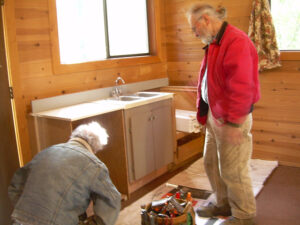
Friends Bruce Dobson and Brent Naylor installing a kitchen in the Oregon cabin.
Some psychologists call it the work of “death and rebirth.” Without the usual distractions of society, or nowadays of media, this first year can be crushing. But that’s not something new. The ancient mystics have, for millennia, written about this difficult challenge of voluntarily undergoing a deep dive of solitary initiation in order to find the self, sometimes in order to heal.
The first year’s difficulties are said to circle around a particular issue. It doesn’t really matter what the issue is. Many retreatants, when faced with emotional pain at this point, might initially place blame on an exterior source. But in time, one comes to see that it’s actually one’s own psyche and patterns and concepts that have created one’s interior struggle. The sooner one realizes that this is a phenomenon—of the mind and of the container of retreat—the sooner and better one will be able to deal with it, and then, to transform it.
After hearing the experiences of others in group three-year retreats, where the relationships between some retreatants become problematic, and then that becomes their “issue,” I felt fortunate to have been on a solo retreat. However, I did have my issue. It was stormy, and wildly difficult at times. And eventually I came to understand it as part of the initiation process.

Friend Spirit Wiseman visited for the last two days of retreat, in Williams.
I worked with my spiritual practices and other techniques of self-therapy I happened to have known about. And at about the eight-month point, it had transformed. I wrote about this at length in the book, and that may be the part where a friend of mine, after reading the book, said she felt it wasn’t the “small boat” story that the title of the book suggests, but a story of a mammoth tanker ship! I knew what she meant.
Once that was behind me it was not always smooth sailing, but the next year was much better. This is common, the second year as a transitional period. The retreatant has settled down considerably, and understands better what long-term, concentrated practice is like. The practices begin to coalesce, with deeper understanding of how they work, the meaning of all the various parts of the practices, and how the parts relate to each other. Interior progress seems to be coming along.
Then, the third year is where, hopefully, the psyche has completely relaxed as the practice has, by then, had some actual impact. A life in solitude is then more than okay—it’s now celebrated. Consciousness is beginning to expand. Spiritual progress is undeniable.
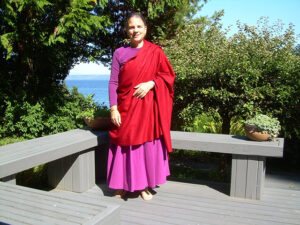
Dressed up for a tsok-offering day, during the third year of retreat, Bainbridge Island.
And important in our tradition, the very concept of progress begins to fade away. This refers to the focus that’s so prevalent in our culture and in our time—of perfectionism, goal-orientation, and striving—which is seen as counterproductive to spiritual development.
As the whole point of Buddhism is the goal of enlightenment, this presents a classic paradox on the spiritual path, difficult to resolve at first. One Buddhist author’s book title is “The Trackless Path,” another title is “Journey Without Goal.” Both titles sum up the perennial problem. How does one achieve, attain, reach enlightenment, without putting in effort, without keeping your eye on the goal? Well, somewhere in the third year of retreat, the answer to that paradox starts to not only become clear, but understanding becomes visceral.
Of course for the third year to bloom, many elements must be in place, beginning with the initial permission and blessings of a qualified lama, who then directs the retreat. This is essential. In addition to strong determination, one tries to keep a pure heart and samaya (the various vows). Imagining the retreat itself as a pure realm, and then maintaining the boundaries and intent, may create a space of blessing like any sacred place, enhancing the ability of the retreatant in their development.

A prayer flag flying next to the garden shed, during an unusually big snow for the San Juan Islands.
What does one do after three-year retreat? It’s very common to need a second long retreat to stabilize the gains of the first. In my case I wasn’t willing to undertake another three-year retreat, but I did follow with a second retreat of nine months, ending in 2016.
Most people, including in Tibet, do not choose to stay in lifelong retreat, but eventually emerge, often to teach. And that is what I did. After taking a break of about a year, which was recommended by my teacher, I created a small-scale endeavor by teaching Buddhism and meditation in Seattle, and then on Zoom. Simultaneously I focused on writing the memoir about retreat – “Small Boat, Vast Ocean: My Years in Solitary Buddhist Retreat,” – which was just published.
There had been something so intensive about the long retreats, that afterward I had an overwhelming sense of wanting to rejoin society. I sought out old friends, and spent time with my grandchildren and elderly mother. Following the Buddhist ethic of not proselytizing, and being quiet about one’s spiritual path, I’ve been enjoying all kinds of society without any push to bring anyone over to the Buddhist way. There’s great freedom in this, to go with the moment, and to give rein to a sense of humor. At the same time, to answer sincere requests to teach.
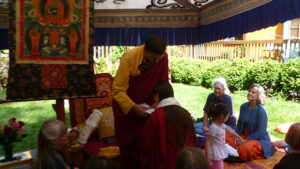
Welcomed out of retreat by Dza Kilung Rinpoche and sangha members, May 3, 2015, Whidbey Island, Pema Kilaya Center.
Of all the vows in Tantric Buddhism, I think my essence-favorite is, “Not to give up love for all sentient beings.” It has no labels, no dogma, no boundaries. At its most expanded, it reflects an enlightened state. This continues to inform and guide me, in my self-reflection and as I navigate the waters of ordinary life, which can mix at any moment, with sacred outlook. And I hope it does inform and guide me, as much as possible from here on. If I have a north star, this love is it.
A native of the Pacific Northwest, Diane Berger began practicing Tibetan Buddhism in 1989. She later brought reincarnated lama Kilung Rinpoche, from Asia to Seattle, where they began a thriving humanitarian organization for his region of Tibet, Kilung Foundation (kilung.org), and a Buddhist sangha for the West, Pema Kilaya (pemakilaya.org), headquartered on Whidbey Island. With a background in journalism, anthropology, and teaching, Berger ran the dual organization for 15 years with Kilung Rinpoche, while studying closely with him and assisting him.
In 2011 she entered three-year retreat, emerging in 2015. While working on her retreat memoir, she taught meditation and Buddhism in Seattle. With the book now published, she’s taking a teaching break while focusing her efforts on bringing the book to the world.
